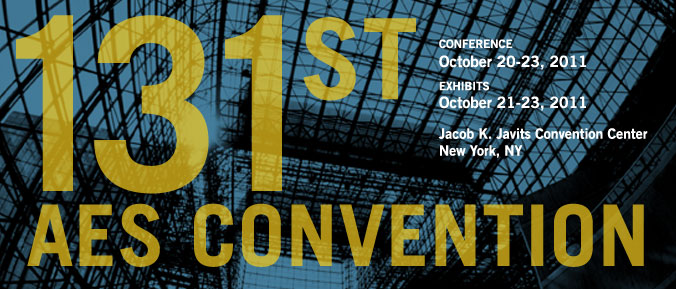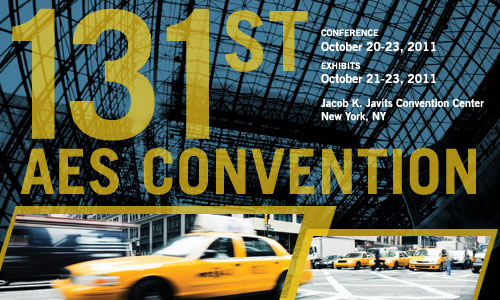
AES New York 2011
Poster Session P11
P11 - Production and Analysis of Musical Sounds
Friday, October 21, 9:30 am — 11:00 am (Room: 1E Foyer)
P11-1 Filling the Gaps between the Grains of Down-Pitching PSOLA or Getting the Frog Out of PSOLA—Adrian von dem Knesebeck, Udo Zölzer, Helmut-Schmidt-University Hamburg - Hamburg, Germany
An improvement regarding the down-pitching quality of the Pitch Synchronous Overlap Add (PSOLA) technique is presented. The behavior of the common PSOLA algorithm when decreasing the input signal's pitch by one octave or even less is analyzed. A new grain processing algorithm is proposed, which modifies the synthesis grains depending on the synthesis period. The time domain and frequency domain properties of the proposed algorithm are discussed. The presented algorithm improves the perceived quality of the PSOLA algorithm when down-pitching while preserving the low complexity.
Convention Paper 8504 (Purchase now)
P11-2 Content-Based Approach to Automatic Recommendation of Music—Bozena Kostek, Gdansk University of Technology - Gdansk, Poland
This paper presents a content-based approach to music recommendation. For this purpose a database that contains more than 50000 music excerpts acquired from public repositories was built. Datasets contain tracks of distinct performers within several music genres. All music pieces were converted to mp3 format and then parameterized based on MPEG-7, mel-cepstral, and time-related dedicated parameters. All feature vectors are stored as csv files and will be available on-line. A study of the database statistical characteristics was performed. Different splits into train and test sets were investigated to provide the most accurate evaluation of the decision-based solutions. Classification time and memory complexity were also evaluated.
Convention Paper 8505 (Purchase now)
P11-3 A Digital Emulation of the Boss SD-1 Super Overdrive Pedal Based on Physical Modeling—Martin Holters, Kristjan Dempwolf, Udo Zölzer, Helmut Schmidt University - Hamburg, Germany
The Boss SD-1 Super Overdrive effect pedal is a classical overdrive circuit for electric guitars. It consists of commonly found building blocks, namely common collector circuits for input and output buffering, the distortion stage as an op-amp circuit with diodes in the feed-back, and a tone-control block as a parametric linear circuit around an op-amp. In this paper we analyze the circuit to derive a digital model where carefully applied simplifications strike a good balance between faithful emulation and computational efficiency. Due to the generality of the analyzed sub-circuits, the results should also be easily transferable to the many similar sub-circuits found in other effect units.
Convention Paper 8506 (Purchase now)
P11-4 A Triode Model for Guitar Amplifier Simulation with Individual Parameter Fitting—Kristjan Dempwolf, Martin Holters, Udo Zölzer, Helmut Schmidt University - Hamburg, Germany
A new approach for the modeling of triodes is presented, featuring simple and physically-motivated equations. The mathematical description includes the replication of the grid current, which is a relevant parameter for the simulation of overdriven guitar amplifiers. If reference data from measurements of practical triodes is available, an individual fitting to the reference can be performed, adapting some free parameters. Parameter sets for individual models are given. To study the suitability for circuit simulations, a SPICE model is created and tested under various conditions. Results of the model itself and when embedded in SPICE simulations are presented and compared with measurements. It is shown that the equations characterize the properties of real tubes in good accordance.
Convention Paper 8507 (Purchase now)
P11-5 Dereverberation of Musical Instrument Recordings for Improved Note Onset Detection and Instrument Recognition—Thomas Wilmering, Mathieu Barthet; Mark B. Sandler, Queen Mary University of London - London, UK
In previous experiments it has been shown that reverberation affects the accuracy of onset detection and instrument recognition. Pre-processing a reverberated speech signal with dereverberation for automatic speech recognition (ASR), where reverberation also decreases efficiency, has been proven effective for mitigating this performance decrease. In this paper we present the results of an experimental study addressing the problem of onset detection and instrument recognition from musical signals in reverberant condition by pre-processing the audio material with a dereverberation algorithm. The experiments include four different onset detection techniques based on energy, spectrum, and phase. The instrument recognition algorithm is based on line spectral frequencies (LSF) and k-means clustering. Results show improvement in onset detection performance, particularly of the spectral-based techniques. In certain conditions we also observed improvement in instrument recognition.
Convention Paper 8508 (Purchase now)
P11-6 Dimensional Reduction in Digital Synthesizers GUI Using Parameter Analysis—Daniel Gómez, Universidad ICESI - Cali, Colombia; Juan Sebastián Botero, Ypisilon Tech - Medellín, Colombia
Digital synthesizers have cognitive overload issues for interaction, specially for novice or intermediate users. A system is developed to generate a custom GUI based on timbre clustering and parameter data analysis of preset programs present in VST synthesizers. The result is a new interface with dynamic control of the amount of variables maintaining full functionality of synthesizer performance. This system is designed to adapt to the degree of knowledge and cognitive control of synthesizer parameters of the user. The results of using diverse clustering techniques for synthesizers sound analysis and an original statistical analysis of preset programs parameter data are exposed. Implications of the use of our system in real world scenarios are reviewed.
Convention Paper 8509 (Purchase now)
Information Last Updated: 20111005, mei

